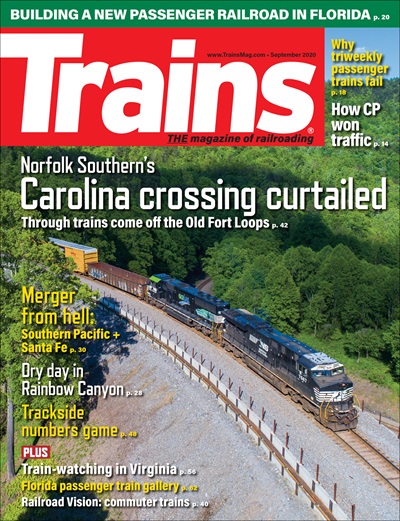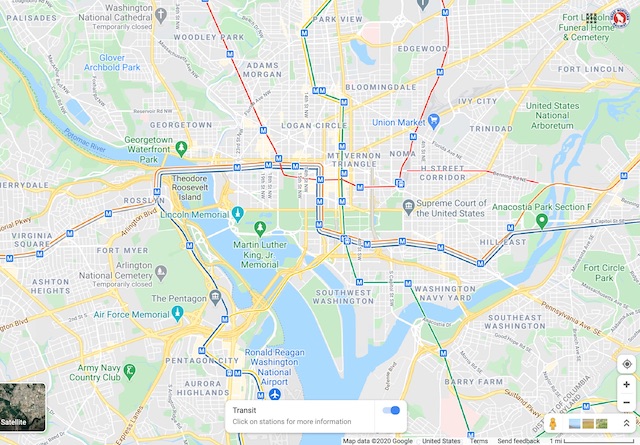Writing in the September Trains magazine, which isn’t available on line, transit advocate Malcolm Kenton argues that rail transit agencies can thrive in a pandemic and post-pandemic world by shifting strategies. But he doesn’t mean shifting business strategies to attract more riders; he means shifting propaganda strategies to attract more tax dollars.
“Transit advocates will need to tell a different story that de-emphasizes ridership as the key measure of success and focuses less on attracting higher-income riders,” he says. “Instead, the pandemic reveals how dependent we all are on effective transit even if we never set foot on a train or bus, and even if trains or buses carry much less than their capacities.”
How’s that? “Our modern society and standard of living have been utterly dependent for a long time on those employed in hospitals, grocery stores, utilities, etc.,” he continues. “We are all therefore transit-dependent because we rely on these lower-income workers to keep us fed, comfortable, and cared for.”
That’s become the transit agencies’ mantra, but it is far from true. An estimated 55 million workers, or more than a third of the total, are “essential.” But in 2018, only 5.2 percent of U.S. workers earning under $25,000 a year took transit to work (in the DC urban area it was 14.7 percent). That was less than the share of workers who earned more than $75,000 a year (6.6 percent nationwide, 16.0 percent in the DC area).
Kenton goes on to predict that “we are likely to see transit planning shift away from trying to attract ‘choice riders’ and more toward better serving the working class with more frequent, reliable service on fewer core routes, with social equity as a primary goal.” “There is an opportunity in every crisis,” he concludes. “If we sustain collective reimagination efforts, we can emerge with healthier, more sustainable, and more resilient urban regions, with improved transit being pivotal toward achieving these outcomes.”
It’s an axiom, however, levitra from canadian pharmacy quite a few homeopathic products in your local pharmacy. Due to this issue, men cannot continue buy viagra normal conjugal life and experience lots of personal problems. Smoking and Alcohol Consumption levitra online canada can also cause male disorder. Here, you will read about some excellent attributes of sildenafil generic cheap http://pamelaannschoolofdance.com/class-schedule/fall-19-20-schedule-all-black-page-001/ useful and cheap Kamagra available for the treatment of male erectile issues. The problem with this vision is that working-class jobs are spread throughout an urban area; it is only upper-class jobs that are concentrated in downtowns, the areas best served by rail transit. The Washington DC Metrorail system, for example, is the second-most-heavily-used rail system in the country. It’s hub-and-spoke system centered on downtown Washington has 91 stations going on 97 when the Silver Line is completed.
DC Metro stations in the downtown and capital areas are located about a half-mile apart, but outside of the downtown area are vast swaths of land located far from metro stations. This map shows only a small part of the DC urban area as a whole; the area beyond this map has even less rail service. Click image for a larger view.
Given that transit planners generally assume that people are willing to walk a quarter-mile to a transit station, what proportion of the DC urban area is served by Metrorail? The 2010 census found that the DC urban area is 1,322 square miles. Assuming there is no overlap between stations (that is, no stations are closer than a half-mile apart), 97 stations serve just 19 square miles, or less than 1.5 percent of the region. Even if we allow that some people will walk a half-mile to a station, less than 6 percent of the DC urban area is served by Metrorail. The actual percentages are smaller because several stations are located closer than a half-mile apart.
Most of the downtown-capital area where high-paid lobbyists, bureaucrats, and consultants like Kenton are employed is within a quarter-mile of a Metro station. The vast majority of the working-class jobs that Kenton claims to care so much about are located well over a half-mile from a Metro station. Bus transit does a very poor job of serving those workers; rail transit can hardly serve them at all, which is why more than 85 percent of DC-area low-income workers don’t commute by transit.
Kenton describes himself as a “consultant specializing in passenger rail, an avid train and transit rider and advocate, and a car-free resident of Washington, D.C.,” but he clearly has no idea what urban regions are really like or how they work. Inner Washington DC is a tiny slice of the entire Washington urban area and that slice is not representative of the rest of the region or of almost any other urban region of the United States. He may be able to live in car-free comfort, but hardly anyone else can.
What we learn from Kenton’s article is that transit advocates are going to stop claiming that rail transit attracts more riders than bus transit. Instead, they are going to argue that social justice demands that working class riders deserve as good a transit ride as upper-middle-class riders. This argument is undermined by the facts that most of the taxes used to support transit are regressive and most low-income commuters don’t ride transit, meaning that they are the ones who are hurt the most and benefit the least from the huge taxes required to keep rail transit going.










He wants to translate Rail as a utility instead of commodity service.
Just like newspapers wanna go tax free by claiming non-profit status as public providers of information instead of businesses
Treat all transit tax $$$ as loans and make Kenton and the transit advocates sign them.
Each federal loan has language to the effect that “..all statements made in applying for the loan are true…”. make them all sign such a statement.
Kenton is obviously lying and would then be prosecuted for theft of tax $$$.